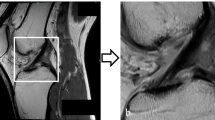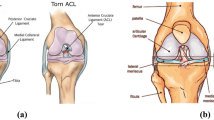Abstract
Magnetic resonance imaging (MRI) is used by surgeons to analyse different tears in the knee part of the body. This technique has demonstrated significant accuracy for the diagnosis of injuries like meniscus tears, ligament injuries, ACL tears, etc. However, studying these MRI manually is very time-consuming and has high chances of wrong prediction. It can take more than thirty minutes to properly examine a knee MRI and come to a result. It is a time-intensive process and has high error probability. Therefore, an automated model for examining knee images to predict the tears would cut the time cost and also the human errors. Generally, deep learning models work best with large amounts of dataset. But, there is not much data present out there of knee injuries which can help to train the model properly. For this purpose, we decided to analyse different deep learning and machine learning algorithms to compare and find the most efficient method. These models were applied on knee MRI dataset for the prediction of anterior cruciate ligament (ACL) tear from sagittal plane MRI scans which provide scans of totally ruptured, partially injured and healthy knees. After our analysis of various models, it was found that the best results were given by Support Vector Machine (SVM) followed by Convolutional Neural Network (CNN) on the masked dataset.
Access this chapter
Tax calculation will be finalised at checkout
Purchases are for personal use only
Similar content being viewed by others
References
Liu J, Pan Y, Li M, Chen Z, Tang L, Lu C, Wang J (2018) Applications of deep learning to MRI images: a survey. Big Data Min Anal 1(1):1–18. https://doi.org/10.26599/bdma.2018.9020001
Pang J, Li P, Qiu M, Chen W, Qiao L (2015) Automatic articular cartilage segmentation based on pattern recognition from knee MRI images. J Dig Imag 28(6):695–703. https://doi.org/10.1007/s10278-015-9780-x
Khalili N, Lessmann N, Turk E, Claessens N, de Heus R, Kolk T, Išgum I et al (2019) Automatic brain tissue segmentation in fetal MRI using convolutional neural networks. Magn Resonan Imag. doi: 10.1016/j.mri.2019.05.020
Štajduhar I, Mamula M, Miletić D, Unal G Semi-automated detection of anterior cruciate ligament injury from MRI. Comput Methods Programs Biomed. https://doi.org/10.1016/j.cmpb.2016.12.006
Naraghi AM, White LM (2016) Imaging of athletic injuries of knee ligaments and menisci: sports imaging series. Radiology 281(1):23–40. https://doi.org/10.1148/radiol.2016152320
Ramakrishna B, Liu Weimin, Saiprasad G, Safdar N, Chang Chein-I, Siddiqui K, Lee San-Kan et al (2009) An automatic computer-aided detection system for meniscal tears on magnetic resonance images. IEEE Trans Med Imag 28(8):1308–1316. https://doi.org/10.1109/tmi.2009.2014864
Bien N, Rajpurkar P, Ball RL, Irvin J, Park A, Jones E, Lungren MP et al (2018) Deep-learning-assisted diagnosis for knee magnetic resonance imaging: development and retrospective validation of MRNet. PLOS Med 15(11):e1002699. https://doi.org/10.1371/journal.pmed.1002699
Raj A, Vishwanathan S, Ajani B, Krishnan K, Agarwal H (2018) Automatic knee cartilage segmentation using fully volumetric convolutional neural networks for evaluation of osteoarthritis. In: 2018 IEEE 15th international symposium on biomedical imaging (ISBI 2018). https://doi.org/10.1109/isbi.2018.8363705
Jaiswal AK, Tiwari P, Kumar S, Gupta D, Khanna A, Rodrigues JJPC (2019) Identifying pneumonia in chest X-rays: a deep learning approach. Measurement (Elsevier) 145:511–518
Chouhan V, Singh SK, Khamparia A, Gupta D, Tiwari P, Moreira C, Damaševičius R, Victor H.C. de Albuquerque (2020) A novel transfer learning based approach for pneumonia detection in chest X-ray images. Appl Sci (MDPI) 10(2):559
Khamparia A, Singh A, Anand D, Gupta D, Khanna A, Arun Kumar N, Tan J (2018) A novel deep learning based multi-model ensemble methods for prediction of neuromuscular disorders. Neural Comput Appl (Springer). https://doi.org/10.1007/s00521-018-3896-0
Prasoon A, Petersen K, Igel C, Lauze F, Dam E, Nielsen M (2013) Deep feature learning for knee cartilage segmentation using a triplanar convolutional neural network. In: Lecture notes in computer science, pp 246–253. https://doi.org/10.1007/978-3-642-40763-5_31
Salvatore C, Cerasa A, Castiglioni I, Gallivanone F, Augimeri A, Lopez M, Quattrone A et al (2014) Machine learning on brain MRI data for differential diagnosis of Parkinson’s disease and progressive supranuclear palsy. J Neurosci Methods 222:230–237. https://doi.org/10.1016/j.jneumeth.2013.11.016
Vijayarani S, Dayanand S (2015) Liver disease prediction using SVM and naïve bayes algorithms 4(4)
Patel J, Modi H, Patel H (n.d) Measurement of cartilage thickness in osteoarthritis and visualization of meniscus tear of knee MRI image processing. IJCSMC 5(1):39–52)
Kumar D, Gandhamal A, Talbar S, Hani AFM (2018) Knee articular cartilage segmentation from MR images. ACM Comput Surv 51(5):1–29. https://doi.org/10.1145/3230631
Author information
Authors and Affiliations
Corresponding author
Editor information
Editors and Affiliations
Rights and permissions
Copyright information
© 2021 The Author(s), under exclusive license to Springer Nature Singapore Pte Ltd.
About this paper
Cite this paper
Kapoor, V., Tyagi, N., Manocha, B., Arora, A., Roy, S., Nagrath, P. (2021). Detection of Anterior Cruciate Ligament Tear Using Deep Learning and Machine Learning Techniques. In: Khanna, A., Gupta, D., Pólkowski, Z., Bhattacharyya, S., Castillo, O. (eds) Data Analytics and Management. Lecture Notes on Data Engineering and Communications Technologies, vol 54. Springer, Singapore. https://doi.org/10.1007/978-981-15-8335-3_2
Download citation
DOI: https://doi.org/10.1007/978-981-15-8335-3_2
Published:
Publisher Name: Springer, Singapore
Print ISBN: 978-981-15-8334-6
Online ISBN: 978-981-15-8335-3
eBook Packages: Intelligent Technologies and RoboticsIntelligent Technologies and Robotics (R0)




